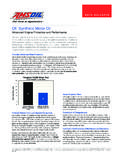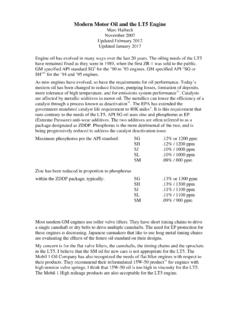Transcription of TTMM DA100 - ChiefAircraft.com
1 TTMM DDAA110000 Owners Manual Introduction The DA 100 was designed to provide the highest quality and performance in Giant Scale modeling.
2 Unlike most other large gas engines on the market, the DA 100 is not a combination of various industrial motor parts. Desert Aircraft computer designed the DA100 from the ground up as a high performance aircraft engine. We did not cut any corners. Existing cylinders, pistons and crankshafts were plentiful and cheap, but did not offer the performance and other features that we needed. The DA 100 pistons, cylinders and crankshaft were designed by, and manufactured exclusively for, Desert Aircraft. Like the TOC Champion DA150, the DA100 features long connecting rods and high piston pin location for better rod angularity and piston tracking. Three large crankshaft bearings are used to offer maximum stability and longevity.
3 The pistons, rods, and crankshaft are very well balanced, providing the smoothest vibration levels for your airframe and radio system in its class. Rather than use a shaft extension to gain clearance between the prop and the cylinders and carburetor, the front section of the case is long, with a bearing right behind the prop hub. Not only does this provide a very stable crankshaft, it also makes fitting the engine and mufflers in the cowl, much easier. The crankcases are CNC milled from 7075 T6 aluminum alloy. Along with excellent fit and finish, precise bearing alignment is insured, which is critical to engine performance. The reliable Desert Aircraft auto advance, electronic ignition system insures easy starting and high performance.
4 This ignition provides a powerful spark, yet is fully shielded to insure protection from R/F noise. Congratulations and thank you from all of us at Desert Aircraft for choosing to own the best in Giant Scale engines! 1 Safety Instructions WARNING! This motor can cause severe harm to you, and/or others, if misused or if these safety precautions and instructions are not observed. Desert Aircraft is not responsible for any loss, injury or damage resulting from the miss-use of its products. ! You alone are responsible for the safe operation of your motor .
5 ! Do not operate the motor if you do not want to be completely responsible for any damage or injury incurred or caused during it s operation. ! Read all instructions before operating your motor . ! If you have any questions about any aspect of operating this motor , do not attempt to start or operate it. ! Never operate the motor , or fly, alone. ! Keep away from the prop while operating the motor . Do not wear loose clothing near the motor or prop. Do not run the motor near loose material such as dirt, gravel, power cords, ropes, sand, etc. Loose material can be drawn into the turning prop causing injury or damage. ! Always operate the motor in an open area. Do not operate indoors. ! This motor can develop tremendous thrust.
6 Make sure the aircraft is properly secured when starting or operating the motor . ! Inspect motor mount bolts and firewall integrity before operating the motor . ! Anyone in the immediate area of the motor should use eye protection during operation of the motor . ! When operating the motor , never stand, or allow anyone else to stand, in front of, or to the side of the propeller. Always stand behind the propeller. ! Keep spectators at least 30 feet away when operating the motor . ! Turn off the motor before making any adjustments. ! Always use the proper size propeller. Never use a damaged, modified or repaired propeller. ! Always use the correct length propeller bolts. Do not use spacers behind the propeller. Spinner cones must not touch the propeller.
7 ! Check that the propeller bolts are tight before every flight. ! Always install an ignition kill switch to stop the motor . ! Adjust the carburetor linkage so that the motor will stop when the carburetor is completely closed. ! Gasoline is extremely flammable. Be careful of any sparks from electrical contacts such as fuel pumps, battery chargers, etc. Do not allow smoking in the area of your fuel supply or motor . Store fuel in approved containers and in well ventilated areas. ! Allow the motor to cool before touching or fueling. ! Always turn the prop a few revolutions after running the motor to discharge the ignition system. ! The ignition system develops extremely high voltage. Do not touch it during operation. 2 motor Installation !
8 Mount the motor using high grade 1/4" or 6mm dia. bolts with washers and locking nuts on the rear of the firewall. Make sure your firewall is structurally sound. The crankshaft centerline is in the exact center of the rear mounting plate bolt pattern. ! The throttle arm is pre-tapped for a 2-56 ball link. Make sure the carburetor's idle set screw is removed or set so that the carb can be fully closed by the servo at low trim. Use a high quality servo for the throttle. A poor quality servo or linkage will not provide accurate and repeatable throttle settings. Don't use metal to metal linkages. ! Un-hook, but don't remove, the throttle return spring if the motor is not going to be bench run. ! Do not try to rotate the carburetor 180 deg.
9 On the mounting block or remove the butterfly shaft assembly. Do not remove the composite carburetor mounting block from the reed valve assembly. It is sealed with a special sealant and may not re-seal correctly if removed. ! When not using case pressure for a smoke pump, make sure the hole for crankcase pressure (back of the case, near the carb mount) is sealed. ! The carburetor needs at least 1 1/2" (38mm) of clearance between the intake and the bottom of the cowl. If there is less than 1 1/2", make an opening in the cowl below the carb at least as large as the carb intake diameter. ! Since the carburetor must often be adjusted differently with the cowl on as compared to off, we recommend small access holes be made in the cowl for adjusting the needle valves with a long, narrow, screw driver.
10 Sometimes the needles can be reached through the cowl's openings for the exhaust system. ! A 32 oz. (or larger) fuel tank is recommended. The tank must be vented. The carb has a strong pump, so the tank can be mounted almost anywhere. The fuel line and tank stopper must be gas compatible. The inner diameter of the fuel tubing should be the same or larger than the carburetor's fuel inlet fitting's inner diameter. Make sure all fuel line connections are secure. Small nylon zip ties work well to keep the fuel line on the metal fittings. Make sure the fuel line is secure and not touching the exhaust or cylinder fins. An inline fuel filter is recommended. ! Cooling is critical to motor performance and longevity. Allow as much cooling air as possible in from the front of the cowl.








